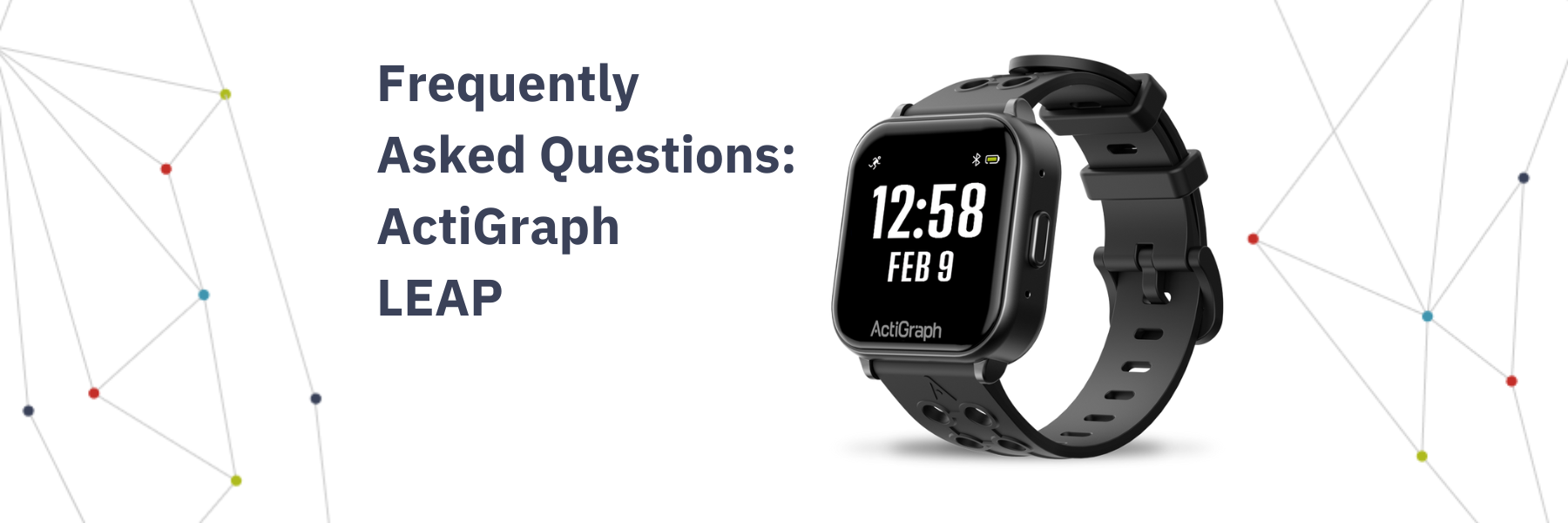
Frequently Asked Questions: ActiGraph LEAP

|
Written by Kim Rejndrup |
The ActiGraph LEAP™ next generation multisensor wearable device is now available for use in academic research and clinical trials. In a recent webinar, experts from ActiGraph and CSEM discussed how the device is designed as a configurable platform to meet a variety of needs for clinical research, while also reducing participant burden with the ability to collect multiple measures in a single fit-for-purpose device. We received a record number of questions from the audience, and we collected the most frequently asked questions and answered them here.
Availability
When is the ActiGraph LEAP available?
It’s available now! Please contact us today if you would like to discuss using the ActiGraph LEAP in your study.
In what countries is it available?
The ActiGraph LEAP is available globally for use in clinical research as prescription use only. Visit our Compliance Center for more details.
Technical Specifications
What is the battery life and how long does it take to charge?
The ActiGraph LEAP has a battery life of up to 32 days. The type and number of sensors used, the sample frequency, and the duration of data collection can impact battery life. Your ActiGraph account manager can provide a more accurate estimate of battery life based on your study protocol.
The device screen will indicate a low power mode when the battery is low. Full charging for a depleted battery takes approximately 3 hours. While the device is being charged, no data will be collected, but this is usually an acceptable gap in data collection. Participants can recharge the device at home via a magnetic charger that self-aligns and is USB block compatible.
What is the memory storage of the device?
The ActiGraph LEAP has an internal memory capacity of up to 1GB. Based on your study protocol, our team will work with you to ensure that wireless data transfers are scheduled at sufficient intervals to capture the data you need.
What are the physical characteristics of the ActiGraph LEAP (thickness, weight, etc.)?
The ActiGraph LEAP device weighs 24 grams and measures 3.85 x 3.9 x 1.225 cm. You can view the full specifications here.
Can the ActiGraph LEAP be used in adult and youth populations?
Yes, the ActiGraph LEAP can be used in adult populations, and use with adolescent population is likely fine depending on your study. Various band sizes and options are available. Very young children or populations with a very small wrist may be a challenge currently. We are performing useability studies to investigate how young a population we can support. This testing primarily involves investigating the form factor and PPG data quality.
Can participants turn the display on and off, for example, while participants are sleeping?
The ActiGraph LEAP device has a high-definition display that can be turned on and off using the button on the side of the device. The display is programmed to turn off automatically after a period of time, and it can be turned on again using the button. Participant data will not be displayed on the screen.
Sensors and Measures
Can sensors be programmed to turn on and turn off at preset times during the study?
Yes, sensors can be turned on/off using sensor modes, event markers, or both. This feature will be available in the first half of 2024.
Sensor modes enable a sensor in the device to be turned on at certain time(s) with predetermined data collection configurations and then be turned off again to conserve battery life.
An event marker can be created by pressing and holding the button on the side of the device for 3 seconds. This can be used similar to a stopwatch to start/stop data capture or pressed once to begin a predetermined data collection period.
What measures are available?
Digital measures of sleep, physical activity, gait and balance, and vital signs are available. Please see the links for details on specific measures, sensors, wear positions, and timelines.
Is the PPG sensor able to obtain accurate measurements on a range of skin types?
Yes, heart rate was measured using PPG sensor on the ActiGraph LEAP device and was tested on all skin types (Fitzpatrick I to VI). No significant difference in heart rate accuracy was seen between skin types.
Data Availability and Algorithms
How can I access raw data collected by the device? Will raw data be available in CentrePoint and ActiLife?
Raw data is available to researchers in the CentrePoint platform via our Data Access API. The data from the device will be transferred via CentrePoint Connect App or the CentrePoint Hub.
ActiLife7.0 software will be updated in Q1 2024 to support raw accelerometer data from the ActiGraph LEAP device with additional sensor data available through 2025.
What algorithms will be available? Can researchers use their own algorithms for processing data?
Sleep, Activity, Gait, Temperature, and Heart Rate algorithms will be available in CentrePoint in Q4 2023. In Q1 2024 we are planning to add IBI, HRV, Skin Temperature, CSEM Wear/No Wear, Circadian Rhythm, and Gait v2 algorithms. These algorithms are available as pluggable APIs, which allow for flexibility and the ability to add new algorithms quicker.
Currently, only ActiGraph's science team can add new algorithms. Our platform roadmap includes adding the ability for external researchers to develop and deploy their own algorithms.
How can researchers differentiate sleep and sedentary behavior near bedtime with the ActiGraph LEAP?
We have several publications on the recent sleep algorithms implemented in CentrePoint, as well as a review article on previous algorithms used to measure sleep and sedentary behavior. This previous work used only accelerometer data, and it can be difficult to distinguish sleep from sedentary behavior. When using the ActiGraph LEAP, we can use algorithms that incorporate heart rate information, which help provide better clarity between sleep and sedentary behavior.
Verification and Validation
Are patients involved in design and usability testing?
Yes, patients are involved in usability testing to provide feedback on usability, comfort, and functionality.
What device validation has been performed?
Technical verification and analytical validation with the ActiGraph LEAP and released algorithms have been completed following the V3 framework for evaluating fit-for-purpose digital measures. Clinical validation is ongoing in a wide range of disease states.
For more information about the ActiGraph LEAP, please contact your ActiGraph account manager, submit a request via our Contact Us page, or visit our Support Center.
